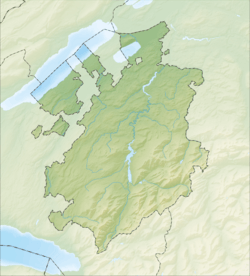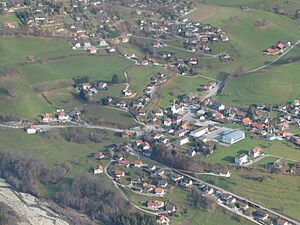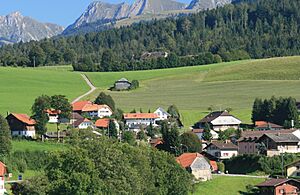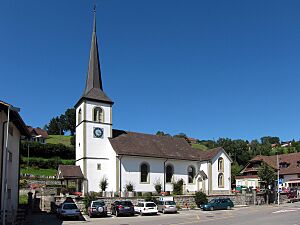Plasselb facts for kids
Quick facts for kids
Plasselb
|
||
|---|---|---|

Plasselb village
|
||
|
||
| Country | Switzerland | |
| Canton | Fribourg | |
| District | Sense | |
| Area | ||
| • Total | 18.16 km2 (7.01 sq mi) | |
| Elevation | 856 m (2,808 ft) | |
| Population
(Dec 2020 )
|
||
| • Total | 1,010 | |
| • Density | 55.62/km2 (144.0/sq mi) | |
| Postal code |
1737
|
|
| Surrounded by | Val-de-Charmey, Giffers, La Roche, Le Mouret, Plaffeien, Sankt Silvester | |
Plasselb is a small town, also called a municipality, located in Switzerland. It is part of the canton of Fribourg, specifically in the Sense district. What makes Plasselb special is that most people there speak German. This is interesting because the Fribourg canton mostly speaks French.
Contents
A Look at Plasselb's Past
Plasselb has a long history. The first time anyone wrote about Plasselb was in the year 1324. Back then, it was known by the name Plannaseyva.
Exploring Plasselb's Geography
Plasselb covers an area of about 18.11 square kilometers (about 7 square miles). A large part of this land is covered by forests, making up about 55.5% of the area. Another big part, 37.1%, is used for farming.
About 4% of Plasselb's land has buildings and roads. A small amount, 1.1%, includes rivers or lakes. The remaining 2.2% is land that cannot be used for farming or building.
The town of Plasselb is found at the bottom of a mountain called Schweinsberg. It sits right at the entrance to a valley known as Plasselbschlund. Since 1971, the nearby area of Neuhaus has also been part of Plasselb.
What Does Plasselb's Coat of Arms Mean?
The blazon (description) of Plasselb's coat of arms is quite unique. It shows a black background with a silver bar across it. On top of this, there is a golden deer jumping. This design represents the municipality.
Who Lives in Plasselb?
Plasselb is home to about 950 people. Most of the people living in Plasselb speak German. In fact, about 93.2% of the population speaks German as their main language. A smaller number of people speak French (2.2%) or Albanian (2.1%).
In 2008, the population was almost evenly split between males and females. About 52.1% were male and 47.9% were female. Most residents were Swiss citizens.
Many people who live in Plasselb were also born there. About 47.9% of the population in 2000 were born in Plasselb. Others were born in the same canton or elsewhere in Switzerland.
The population of Plasselb has changed over time. Here's how the number of people living in Plasselb has grown or shrunk:

How People Work in Plasselb
In Plasselb, many people are employed. In 2008, there were 111 full-time jobs available. These jobs were spread across different types of work.
- Farming and Forestry: About 31 jobs were in the primary sector. This includes working in agriculture and forestry, like cutting down trees.
- Factories and Building: The secondary sector had 32 jobs. These jobs were in manufacturing (making things) and construction (building things).
- Services: The tertiary sector had 48 jobs. This sector includes services like sales, transportation, hotels, restaurants, and education.
Most people who work in Plasselb actually travel to jobs outside the municipality. In 2000, about 419 workers left Plasselb for work, while only 34 came into Plasselb for work. Most people (72.6%) used a private car to get to work.
Religion in Plasselb
In 2000, most people in Plasselb were Roman Catholic, making up about 81.3% of the population. Another 7.3% belonged to the Swiss Reformed Church.
A small number of people followed other Christian faiths or were Islamic. About 4.29% of the population did not belong to any church, meaning they were agnostic or atheist.
Learning and Education in Plasselb
Education is important in Plasselb. About 35.3% of the population has finished upper secondary education. This is like high school. Another 7.2% have gone on to higher education, such as university.
The Fribourg school system has a specific structure:
- Kindergarten: One year of non-required kindergarten.
- Primary School: Six years of primary school.
- Lower Secondary School: Three years of required lower secondary school. Students are grouped by their abilities.
- Upper Secondary School: After lower secondary, students can choose a three or four-year optional upper secondary school. This can be a gymnasium (which prepares students for university) or a vocational program (which teaches job skills).
- Tertiary School: After upper secondary, students can go to a tertiary school or start an apprenticeship.
In the 2010-2011 school year, 86 students were attending classes in Plasselb. Many students from Plasselb also went to schools in nearby towns for their education.
See also
 In Spanish: Plasselb para niños
In Spanish: Plasselb para niños







